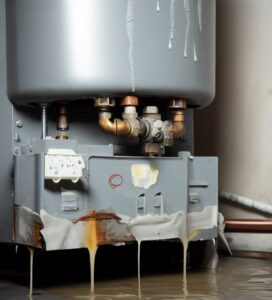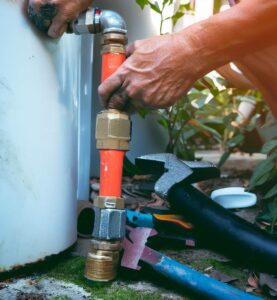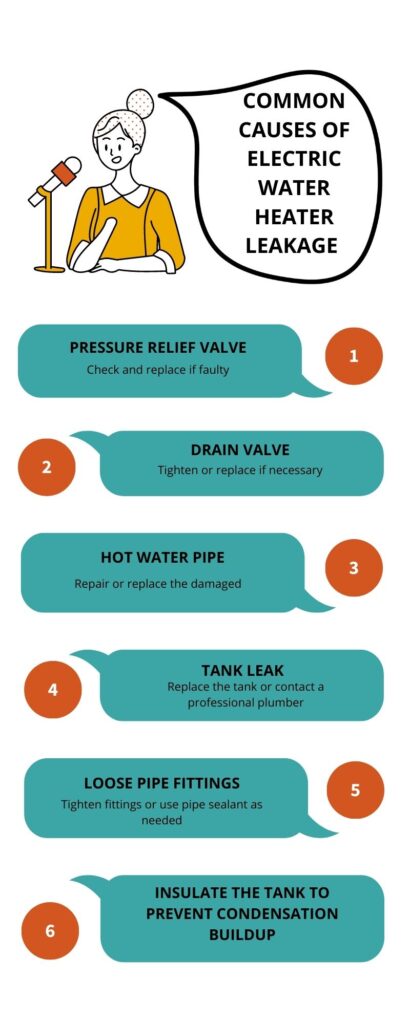Table of Contents
Leaking electric water heaters can cause serious damage if not fixed quickly. We’ll look at the steps and techniques to fix this problem.
Key Steps
- Step 1: Leaks can come from the tank, pipes, valves, or fittings. It’s important to find the source before attempting repairs. Leaks can be caused by pressure, corrosion, or a bad relief valve.
- Step 2: To fix a leaking pressure relief valve, turn off the power to the unit. Open a faucet in the house to reduce pressure. Use a wrench to tighten the valve slightly – but don’t overtighten it. If that doesn’t work, replace the valve.
- Step 3: If the leak is from the drain valve or pipe fittings, check for loose connections and use a wrench to tighten them. Worn-out threads may need to be resealed with tape or sealant.
- Step 4: If the leak is from an internal component like an anode rod or heating element, you may need to replace it. Regular maintenance and inspection can help prevent such issues.
- Step 5: Leaks from the top could require repair or replacement of pipes or T&P valves. If there are cracks or leaks, replace them following manufacturer instructions.
Note: In some cases, you may need professional help to fix a leaking electric water heater. Plumbers are experts and can make sure the problem is fixed safely.
Identifying the Leaking Water Heater
Watch out for water heater leaks! They can be a common household issue, so don’t ignore them. If your electric water heater is leaking, it’s important to take action fast to prevent more damage. Here’s a quick guide on how to find a leak and address it:
- Look for visible signs of water near the unit: Check for puddles, dampness, moisture stains, and rust stains on the floor or walls.
- Examine the pressure relief valve: Check if it’s dripping or spraying. Malfunctions can cause too much pressure and lead to leaks.
- Inspect the drain valve: Make sure it’s tightly closed and not leaking.
- Check all pipe fittings and connections: Tighten up any loose ones with a pipe wrench, and replace any damaged parts.
- Look out for condensation: Sometimes what looks like a leak may be condensation due to temperature differences. Wipe off the moisture and see if it returns.
- Monitor your hot water usage: A sudden increase could mean a hidden leak in the plumbing, not the electric water heater.
Be sure to look for other details too, like cold-water inlet pipe leaks, anode rod corrosion, and the shutoff valve. Plus, hire a pro for maintenance and periodic check-ups to catch potential issues early.

Follow these steps and you’ll soon identify that leaking electric water heater — no tears necessary!
Safety Precautions while handling leaky Electric Water Heater
Ensuring safety when mending a leaking electric water heater is key. Here’s what to keep in mind:
- Turn off the power! Prior to beginning repair work, make sure the power supply to the water heater is switched off. This eliminates the risk of electrical shock and keeps you safe.
- Shut off the water supply. Find the shutoff valve on the cold water supply line and turn it clockwise to switch off the flow. This halts any further water leakage and damage.
- Drain the tank. Attach a garden hose to the drain valve at the bottom of the heater. Open it and let all the water out. Be watchful; the hot water might cause burns.
- Release pressure. Open a hot water faucet in your house to relieve pressure inside the tank and reduce risks while tinkering with it.
Besides these precautions, always remember to wear protective gear such as gloves and goggles when dealing with water heaters. Safety should be your priority. So, if you feel unsure or uncomfortable doing the repairs yourself, don’t hesitate to call a professional plumber who can help you safely.
By following these safety measures, you can minimize risks associated with fixing a leaking electric water heater and protect yourself from any harm that might occur. Don’t wait to act on leaks or else you could end up with costly repairs or extensive water damage to your home. Take prompt and responsible action for your own well-being.
Gathering the Necessary Tools to fix leaky Electric Water Heater
Gathering the necessary tools for a successful response to the task requirements is all about being prepared. Here’s a 4-step guide to help get you set:
- Grab a pipe wrench – this tool will come in handy for loosening and tightening various pipe fittings.
- Don’t forget a garden hose – use this to drain water from your water heater tank.
- Locate your power shut-off – this ensures safety while working on your hot water heater.
- A flashlight is a must – it’ll help you see dark corners of your water heater to identify potential issues.
Having pliers and a bucket nearby can also be useful if something unexpected pops up.

Safety first! Consider calling a professional plumber if you’re not sure how to proceed.
Pro Tip: Before starting repairs, turn off both the cold water supply valve and hot water outlet valve to stop water leakage. It’s like a break-up – cut off all connections before things get messy!
Shutting Off Power and Water Supply of Electric Water Heater
When dealing with a leaking electric water heater, it’s important to take safety measures. Here’s what to do:
- Turn off the power. Find the circuit breaker or fuse box in charge of the water heater and switch off the corresponding breaker or remove the fuse.
- Shut off the water supply. Find the cold water supply valve connected to the water heater and turn it clockwise to stop any additional water from filling up the tank.
- Drain the tank. Connect a hose to the drain valve at the bottom of the tank. Put the other end of the hose in a suitable drainage area (e.g. floor drain or outside). Open the valve slowly to release any hot water and reduce the pressure inside the tank.
It’s recommended to call a licensed plumber to handle repairs. For efficient maintenance and prevention of costly repairs in future, regular inspection of your electric water heater is necessary.
Locating the Source of the Leak from Electric Water Heater
If you have a leaking electric water heater, quickly locate the source to prevent further damage. Here’s how:
- Check for visible leaks – look for puddles, dampness or water stains around the unit.
- Examine supply pipes and fittings – check connections between the water heater and the cold and hot water lines for loose or damaged fittings.
- Inspect pressure relief valve – should be on the side or top of your unit, check for any signs of leakage.
- Look for condensation – sometimes, moisture is just condensation on the outside of the tank. Wipe away and observe.
- Check internal tank issues – if external source ruled out, seek professional inspection.
Remember – delay repairs can lead to more serious issues, like water damage or electrical component failure. Take prompt action and reach out to a plumber to address the leak and maintain optimal performance. So don’t wait, get it sorted today!
Common Causes of Electric Water Heater Leakage and Corresponding Solutions
Leaking electric water heaters are a common issue faced by homeowners. This can be a frustrating and damaging problem. Let’s look at the causes and solutions.
- Cause: Pressure Relief Valve – Check and replace if faulty.
- Cause: Drain Valve – Tighten or replace if necessary.
- Cause: Hot Water Pipe – Repair or replace the damaged section.
- Cause: Tank Leak – Replace the tank or contact a professional plumber.
- Cause: Condensation – Insulate the tank to prevent condensation buildup.
- Cause: Loose Pipe Fittings – Tighten fittings or use pipe sealant as needed.
Remember, regular maintenance of your electric water heater can help prevent leaks. Inspect connections, valves, and fittings for any signs of wear or damage. Listen for unusual noises or fluctuations in water temperature.

A couple living in an old house had minor puddles near their electric water heater. They found out it was from a faulty pressure relief valve. They called a professional plumber who replaced the valve.
For persistent leaks, contact plumbing experts or professional plumbers. They can assess the situation and provide solutions. Fixing leaks is like stopping a waterfall with a Band-Aid – but hey, at least it’s a start!
Repairing the Leaks from Electric Water Heater
- Turn off the power at the breaker panel for safety.
- Then shut off the cold water supply valve.
- To find the leak, check all visible pipes, fittings, valves and connections.
- Tighten loose connections with a pipe wrench or adjustable wrench.
- If you can’t find a visible leak, an internal tank leak might be present.
- Attach a garden hose to the tank’s drain valve and run hot water through it.
- If there is water leakage, call a professional.
- Make sure to inspect components like the anode rod and do any maintenance recommended by manufacturers.
- High water pressure can also cause leaks.
- Follow these steps to repair any leaks and keep the water heater functioning for years.
- Regular maintenance is key!
Performing Regular Maintenance to Prevent Future Electric Water Heater Leaks
Maintaining your electric water heater is vital to avoid future leaks. A few simple steps can help you keep your appliance running and dodge pricey repairs.
- Inspect valves and fittings for any damage or leakage. Be aware of loose connections or corrosion, which can cause leaks in time.
- Flush the tank every six months. Connect a garden hose to the drain valve at the bottom of the tank and flush until the water is clear.
- Test the pressure relief valve. Lift the lever and let it snap back. You’ll hear a gurgling sound as water is released.
- Replace the anode rod if needed. This helps prevent corrosion and should be checked annually. Replace it if more than six inches are exposed or it’s corroded.
By following these steps regularly, you can reduce the odds of future water heater leaks. Don’t forget the story of the homeowner who experienced a major leak due to lack of maintenance. It’s a lesson in the importance of being prepared for future problems.
So remember, just like unclogging your emotions, fixing a leaking electric water heater takes time, patience—and a good plumber on speed dial.
Frequently Asked Questions
1. Can a leaking water heater be fixed?
Yes, a leaking water heater can be fixed. However, the extent of the repair may vary based on the cause and severity of the leak. In some cases, a simple fix like replacing a valve or tightening a connection may solve the issue. But if the leak persists or is due to a major internal tank problem, it may be more cost-effective to replace the water heater entirely.
2. What should I do if my electric water heater is leaking?
If you discover a leak in your electric water heater, it’s important to take immediate action to prevent further damage. Begin by shutting off the power supply to the water heater at the breaker box. Then, turn off the cold water supply to the heater. Finally, consult a professional plumber to assess and repair the leak.
3. How can I fix a leaking hot water heater pressure relief valve?
To fix a leaking hot water heater pressure relief valve, turn off the power and water supply to the heater. Then, drain some water from the tank to relieve pressure. Use a pipe wrench to remove the existing valve and replace it with a new one. Ensure proper installation and check for any additional leaks before restoring power and water supply.
4. How do I fix a leaking hot water heater drain valve?
If your hot water heater drain valve is leaking, start by turning off the power and water supply. Attach a garden hose to the drain valve, and place the other end in a suitable drain or outside. Open the valve to drain the water from the tank. Once fully drained, use an adjustable wrench to remove the old drain valve and replace it with a new one. Finally, check for any leaks and restore power and water supply.
5. What should I do if my hot water heater is leaking from the top?
If you notice a leak from the top of your hot water heater, it could indicate a problem with the pressure relief valve, inlet pipe, or fittings. Turn off the power and water supply, then inspect the area for any loose connections or damaged components. Tighten any loose fittings and replace any faulty parts as necessary. If the issue persists, contact a professional plumber for further assistance.
6. How can I stop a leaking hot water heater?
To stop a leaking hot water heater, follow these steps: turn off the power and water supply, drain the tank if needed, identify and repair the source of the leak (such as a valve, pipe, or tank issue), replace any damaged parts, and finally, restore power and water supply. If the leak continues, or if you’re unsure of how to proceed, it’s best to consult a professional plumber.
Conclusion
In conclusion, sorting out a leaking hot water heater requires you to first discover the source. It may be possible to solve the problem with some maintenance work, or it might need a pro’s help.
To start, shut off the power and water supply. Use a pipe wrench to tighten any loose connections or replace any damaged pipes. Check for leaks afterwards to be sure the fix was successful.
If the pressure relief valve is the cause of all the leaking, it probably needs to be swapped out. This valve’s purpose is to let go of too much pressure to avoid explosions. But, it shouldn’t be leaking all the time. A plumber can inspect and replace it if needed.
